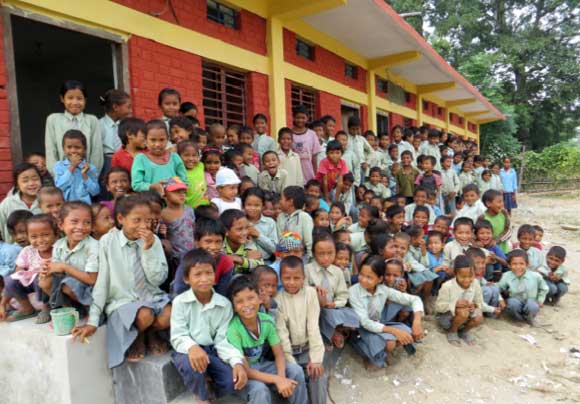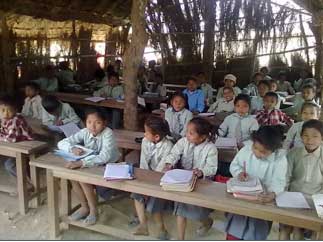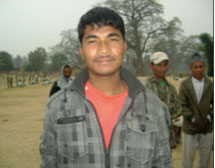The Primary School in Mahu was completed on September 28, 2012!

Mahu's New School
Mahu Community Profile
Mahu is part of the Baijapur VDC (Village Development Committee) in the Banke District of far western Nepal. This community was founded more than 150 years ago. Today there are 1,870 people living in 223 households in Mahu. The majority follow Hindu religious traditions and most also belong to the Tharu ethnic group. The Tharu make up about 6.5% of Nepal’s total population, and until the practice was banned in 2000 many Tharu were forced into a form of indentured servitude called Kamaiya. Ther are 15 ex-Kamaiya families in Mahu.
Mahu is 215 km from the buildOn office in Dhangadhi. The elected leader of the community is Mr. Man Bahadur Tharu. The Rapti River runs 1 km north of the village, and there is a dense forest just 500 meters from the community. Agriculture is the primary income generating activity in Mahu. Families grow rice, wheat, oilseed, and vegetables. The climate is warm for most of the year, with cooler temperatures from November to January and the heaviest rains from June to August.
Mahu is 215 km from the buildOn office in Dhangadhi. The elected leader of the community is Mr. Man Bahadur Tharu. The Rapti River runs 1 km north of the village, and there is a dense forest just 500 meters from the community. Agriculture is the primary income generating activity in Mahu. Families grow rice, wheat, oilseed, and vegetables. The climate is warm for most of the year, with cooler temperatures from November to January and the heaviest rains from June to August.
The Prior School Situation

The Old School

An Old Classroom
Jan Bhawana Primary School: There are currently 211 students enrolled in Jan Bhawana Primary School- 96 girls and 115 boys. They study with 4 teachers in grades 1 through 3. This school was formally established just 4 years ago. Before that, children of all ages walked about 2 km to another community school.
Prior to this project there were no permanent classrooms in Mahu and students in grades 4 and above either walked the 2 km to school or dropped out entirely. Students studied in buildings made of wood and mud with thatched roofs that leaked during the rainy season and were easily damaged during monsoons. The new school will allow many more students to continue their education past 3rd grade in Mahu!
Prior to this project there were no permanent classrooms in Mahu and students in grades 4 and above either walked the 2 km to school or dropped out entirely. Students studied in buildings made of wood and mud with thatched roofs that leaked during the rainy season and were easily damaged during monsoons. The new school will allow many more students to continue their education past 3rd grade in Mahu!
The Mahu School Project
The Mahu school project broke ground on March 27th 2012 and was completed on September 28th 2012. The people of Mahu contributed a total of 1,774 volunteer workdays to the project, which finished behind schedule for two reasons: first, a strike blocked major roads and prevented the delivery of materials for several weeks, and second, this delay pushed the construction into the monsoon season. Community members worked through the rains (at a much slower pace than in the dry season) to finish the school.
The school has 3 classrooms as well as 2 latrines as well as desks and seats and permanent chalkboards. This project began on March 27, 2012 with the help of a Trek for Knowledge team of high school students from buildOn’s afterschool program in Chicago. These students were chosen from several different high schools and earned the opportunity to participate in the Trek after doing extensive local community service with buildOn. In Mahu they lived with host families, participating in cultural workshops and working side by side with community members for 10 days on the worksite. Per Opportunity for All / buildOn methodology, before beginning construction they also joined the entire community and buildOn staff to sign a covenant outlining the following responsibilities:
Community Contribution
• Unskilled labor: 20 workers (10 women and 10 men) per day, six days per week
• Commitment to educating girls and boys equally
• The land on which the school will be built
• High quality local materials: sand, gravel, water & rocks
• Volunteer management committee made up of 12 villagers (six women, six men)
• Lodging for buildOn Field Coordinator and skilled laborers in local homes
• Basic construction tools (picks, buckets, etc.) when available
Opportunity For All / buildOn Contribution
• Engineering and architecture
• Construction materials (excluding local materials) for school and latrine
• Skilled labor and plans needed to build the school
• Project management (buildOn coordinators)
• Instruction in basic construction techniques
• School furniture
The school has 3 classrooms as well as 2 latrines as well as desks and seats and permanent chalkboards. This project began on March 27, 2012 with the help of a Trek for Knowledge team of high school students from buildOn’s afterschool program in Chicago. These students were chosen from several different high schools and earned the opportunity to participate in the Trek after doing extensive local community service with buildOn. In Mahu they lived with host families, participating in cultural workshops and working side by side with community members for 10 days on the worksite. Per Opportunity for All / buildOn methodology, before beginning construction they also joined the entire community and buildOn staff to sign a covenant outlining the following responsibilities:
Community Contribution
• Unskilled labor: 20 workers (10 women and 10 men) per day, six days per week
• Commitment to educating girls and boys equally
• The land on which the school will be built
• High quality local materials: sand, gravel, water & rocks
• Volunteer management committee made up of 12 villagers (six women, six men)
• Lodging for buildOn Field Coordinator and skilled laborers in local homes
• Basic construction tools (picks, buckets, etc.) when available
Opportunity For All / buildOn Contribution
• Engineering and architecture
• Construction materials (excluding local materials) for school and latrine
• Skilled labor and plans needed to build the school
• Project management (buildOn coordinators)
• Instruction in basic construction techniques
• School furniture
Education makes a man aware and empowers him. I hope this school will be upgraded to lower secondary school with quality education. The number of kids will increase, and I hope the number of female students will also increase. I will help build this new school so that our small kids need not go far away to class.
- Mr. Bikram Tharu, parent and school chairperson

The number of students will now increase, and the number of girl students. The community has learned unified work can help to develop our village, and people will work hard for
community development.
- Mr. Yadav K.C., principal, age 26
Thanks so much to the buildOn US team who did a good job with us. We are very happy! I will always remember them!
- Rampati Tharu, student, age 10
